JAPAN’S PATH TO WAR WITH U.S. PASSES THROUGH ITALY’S TARANTO
Tokyo, Japan • November 11, 1940
Seventh child to a Japanese schoolmaster and his second wife and named “Isoroku” to memorialize his father’s age (56), the future commander of the Imperial Japanese Navy’s Combined Fleet (Rengō Kantai) for much of World War II would seem to have been born under what Westerners call “a lucky star.” From the time he served as naval attaché at Tokyo’s embassy in Washington, D.C. (1925 to 1927) and even before as a student at Harvard University in Boston, Massachusetts (1919 to 1921), until his violent death at age 59 on April 18, 1943, by a vengeful United States, Adm. Isoroku Yamamoto appears to have weathered World War II historiographical maelstroms better than most of his compatriots of the period.
Yamamoto’s first major assignment was executive officer at a recently opened naval air-training school north of Tokyo. From that point on in his naval career Yamamoto pressed for the development of aircraft, fighter and torpedo planes especially. He and U.S. Army Gen. William “Billy” Mitchell shared similar viewpoints about air power. “The day has passed,” Mitchell prophesied in late 1918, “when armies on the ground or navies on the sea can be the arbiter of a nation’s destiny in war. The main power of defense and the power of initiative against an enemy has passed to the air.” One product of Yamamoto’s pressure was the famed Mitsubishi Zero fighter plane of World War II. Another was pushing the navy to build more aircraft carriers, which in time led to the Shokaku and Zuikaku, the biggest and fastest carriers Japan had yet built.
Yamamoto had frequent praise and respect for America and Americans. Following his country’s surprise attack on U.S. Pacific assets in Hawaii on December 7, 1941, he became America’s favorite villain overnight. After all, Yamamoto was the chief architect of that infamous attack. Yet in 1934, opposing Gen. Mitchell’s stance on the inevitability of war with Japan, Vice Adm. Yamamoto said, “I have never thought of America as a potential enemy, and the naval plans of Japan have never included the possibility of an American-Japanese war.” In the late 1930s/turn of the ’40s Yamamoto was a leading proponent of avoiding war with the United States. He and many higher-ups in the Japanese Navy saw eye to eye in believing their navy was too weak to oppose the U.S. Navy and would remain so for some time. But Japan’s government came under irrepressible pressure from the Japanese Army, chiefly from the country’s Minister of War (July 22, 1940, to July 22, 1944) and future prime minister (October 18, 1941, to July 22, 1944), Gen. Hideki Tōjō, and Gen. Tōjō set a collision course with America.
As head of the Combined Fleet Yamamoto realized that if his country was facing an inevitable conflict with a powerful adversary like the U.S., he was duty-bound to give Japan a fighting chance. So, in late spring 1940 he began mulling over ways to cripple the U.S. fleet at anchor in Pearl Harbor in the mid-Pacific in the opening hours of the war. Months later, on this date, November 11, 1940, 2 flocks of British biplanes armed with torpedoes lifted off the carrier HMS Illustrious in the Mediterranean Sea to launch the first all-aircraft, ship-to-ship naval attack in history, bludgeoning Italy’s Regia Marina at Taranto, the country’s main naval base, for the loss of 2 aircraft, 2 killed, and 2 captured. Yamamoto dispatched 2 assistant naval attachés to Taranto to investigate and report back on the carrier air strike firsthand.
Early in 1941 Yamamoto outlined an attack plan similar to the Royal Navy’s air attack on Taranto. In April 1941 he ordered plans drawn up for Operation Z, a dicey preemptive air and naval attack on Pearl Harbor, confiding to a staff officer, “If we fail, we’d better give up the war.” Far from failing, Yamamoto’s strike removed 88 percent of the U.S. Pacific Fleet’s battleships (or 60 percent of the U.S. Navy’s capital ships) from combat service in less than 3 hours at little cost. The war between Japan and the United States and its allies would last for 1,365 days.
Japanese Attack on Pearl Harbor, December 7, 1941
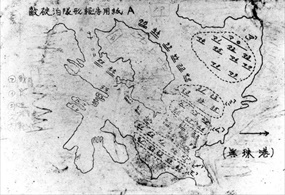 | 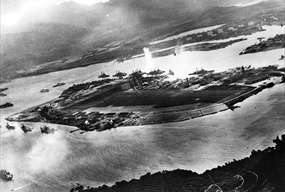 |
Left: A sketch identifying ship mooring locations and titled (at upper left) “Report on positions of enemy fleet at anchorage” after it was recovered from a Japanese aircraft that was downed during the attack on Pearl Harbor. Operation Z had a Hawaiian spy network component, half of which consisted of a young 28-year-old, real name Takeo Yoshikawa, whose cover was that of Japanese vice consul officer trainee Morimura Tadachi working in the office of consul general Kita Nagao, who himself was a secret agent of the Joho Kyoku, the intelligence service of the Imperial Japanese Navy. Yoshikawa was assisted by a 2‑person team of Joho Kyoku agents, plus local fishermen, painters, and simple tourists. The other half consisted of the Kuehns, a Nazi husband-and-wife team working in the pay of both Germany and Japan. The Kuehns rented a cottage overlooking Pearl Harbor. The spy network provided information leading to the success of Japan’s surprise attack; for example, tourist postcards of important landmarks mailed “home,” best day of the week for an attack (Sunday), best time of day (early morning), best Oahu flight gateway for reaching Pearl Harbor (via Kolekole pass), location of military assets in and around Honolulu the capital, etc.
![]()
Right: Aerial view of the first blows striking American battleships moored at Battleship Row as seen in this captured Japanese photograph taken during the initial moments of the Japanese air attack on Pearl Harbor. A water spout caused by an exploding bomb appears near the stern of the battleship in the middle of the photo.
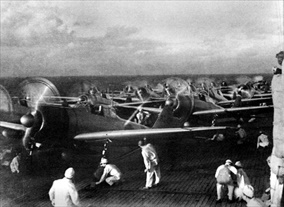 | 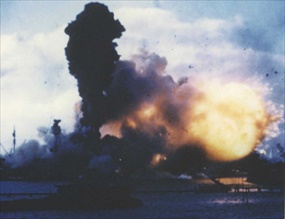 |
Left: Aircraft prepare to launch from the Imperial Japanese Navy aircraft carrier Akagi during the December 7, 1941, attack on Pearl Harbor, Hawaii.
![]()
Right: The forward magazines of the battleship USS Arizona explode after she was hit by a Japanese bomb on December 7, 1941. Swarms of Japanese aircraft can barely be seen overhead in the background as tiny dots. The still image is from a color motion picture taken on board the hospital ship USS Solace.
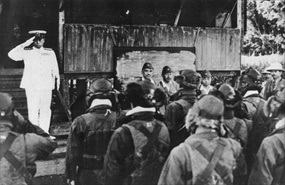 | 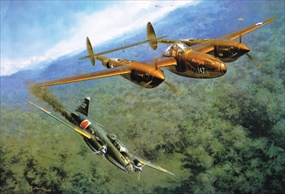 |
Left: Adm. Yamamoto salutes Japanese naval pilots at Rabaul a few hours before his death. Yamamoto was at the former Australian airbase on New Britain Island (today a province of Papua New Guinea in the southwestern Pacific Ocean) to supervise carrier-based air operations during Operation I‑Go (April 1–16, 1943). I‑Go had limited success in delaying, much less halting, Allied offensives in the South Pacific, but Yamamoto never lived long enough to learn that. His plans to congratulate naval units that had taken part in I‑Go and to boost sagging troop morale after Japanese defeats on New Guinea (January–February 1943) and Guadalcanal (February 1943) Islands and at sea (Battle of the Bismarck Sea, March 24, 1943) were cut short on April 18, 1943, when he and his party were ambushed and killed en route to an airbase off Bougainville Island by a squadron of U.S. P‑38 Lightning fighter aircraft.
![]()
Right: The 59-year-old admiral was bushwhacked after U.S. naval intelligence decrypted the itinerary of his Solomon Islands area tour, enabling U.S. Army Air Forces Lockheed P‑38s operating from Guadalcanal to shoot down his transport bomber. Yamamoto’s death was a major blow to Japanese military morale during World War II, while it raised U.S. morale. In this painting by Roy Grinnell, the Mitsubishi G4M Betty twin-engine bomber carrying Yamamoto begins a death spiral into the jungle of Bougainville. Operation Vengeance, as the shoot-down was called, was revenge by U.S. leaders, who blamed Yamamoto for the December 7, 1941, air and naval attack on Pearl Harbor that initiated the war between Japan and the United States. Source of Grinnell’s painting WWII History, June 2022.
Japanese and U.S. Naval Preparations on Eve of December 7, 1941
![]()

 History buffs, there is good news! The Daily Chronicles of World War II is now available as an ebook for $4.99 on Amazon.com. Containing a year’s worth of dated entries from this website, the ebook brings the story of this tumultuous era to life in a compelling, authoritative, and succinct manner. Featuring inventive navigation aids, the ebook enables readers to instantly move forward or backward by month and date to different dated entries. Simple and elegant! Click
History buffs, there is good news! The Daily Chronicles of World War II is now available as an ebook for $4.99 on Amazon.com. Containing a year’s worth of dated entries from this website, the ebook brings the story of this tumultuous era to life in a compelling, authoritative, and succinct manner. Featuring inventive navigation aids, the ebook enables readers to instantly move forward or backward by month and date to different dated entries. Simple and elegant! Click 











